YAMAHA RHINO 700 2013 Owners Manual
Manufacturer: YAMAHA, Model Year: 2013, Model line: RHINO 700, Model: YAMAHA RHINO 700 2013Pages: 188, PDF Size: 4.9 MB
Page 171 of 188
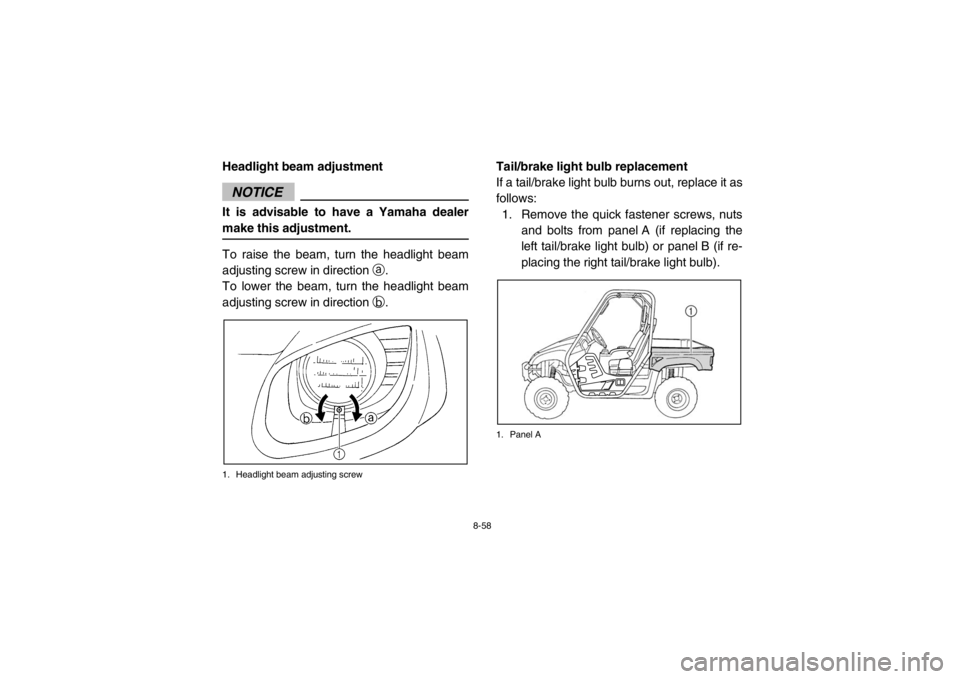
8-58
EVU00990Headlight beam adjustmentNOTICEIt is advisable to have a Yamaha dealer
make this adjustment.To raise the beam, turn the headlight beam
adjusting screw in directiona.
To lower the beam, turn the headlight beam
adjusting screw in direction b.1. Headlight beam adjusting screw
EVU01000Tail/brake light bulb replacement
If a tail/brake light bulb burns out, replace it as
follows:
1. Remove the quick fastener screws, nuts and bolts from panel A (if replacing the
left tail/brake light bulb) or panel B (if re-
placing the right tail/brake light bulb).1. Panel A
1RB7A_EE.book Page 58 Tuesday, April 24, 2012 9:07 AM
Page 172 of 188
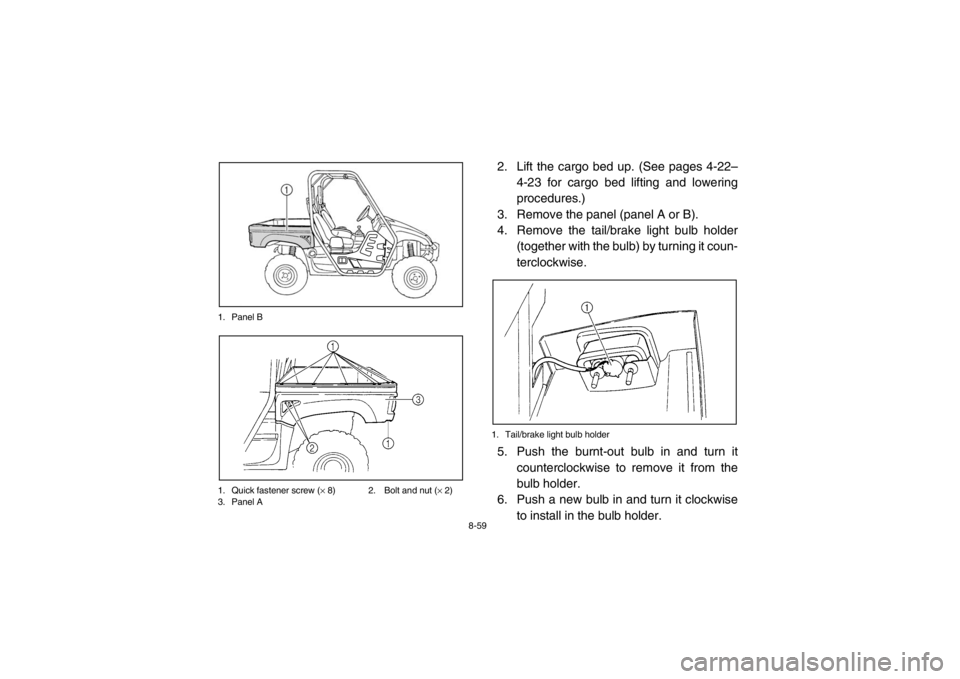
8-59
1. Panel B
1. Quick fastener screw (
× 8) 2. Bolt and nut ( × 2)
3. Panel A
2. Lift the cargo bed up. (See pages 4-22–
4-23 for cargo bed lifting and lowering
procedures.)
3. Remove the panel (panel A or B).
4. Remove the tail/brake light bulb holder (together with the bulb) by turning it coun-
terclockwise.1. Tail/brake light bulb holder5. Push the burnt-out bulb in and turn it
counterclockwise to remove it from the
bulb holder.
6. Push a new bulb in and turn it clockwise
to install in the bulb holder.
1RB7A_EE.book Page 59 Tuesday, April 24, 2012 9:07 AM
Page 173 of 188

8-60
7. Install the bulb holder (together with thebulb) by turning it clockwise.
8. Install the panel.
9. Lower the cargo bed.
10. Install the quick fastener screws, bolts and nuts, and then tighten the nuts to the
specified torque.
EVU01010Troubleshooting
Although Yamaha vehicles receive an inspec-
tion before shipment from the factory, trouble
may occur during operation. Any problem in
the fuel, compression, or ignition systems can
cause poor starting and loss of power. The
troubleshooting chart describes a quick, easy
procedure for making checks. If your vehicle
requires any repair, take it to a Yamaha deal-
er.
The skilled technicians at a Yamaha dealer-
ship have the tools, experience, and know-
how to properly service your vehicle. Use only
genuine Yamaha parts on your vehicle. Imita-
tion parts may look like Yamaha parts, but
they are often inferior. Consequently, they
have a shorter service life and can lead to ex-
pensive repair bills.
Tightening torque:
Panel nut: 7 Nm (0.7 m·kgf, 5.1 ft·lbf)
1RB7A_EE.book Page 60 Tuesday, April 24, 2012 9:07 AM
Page 174 of 188
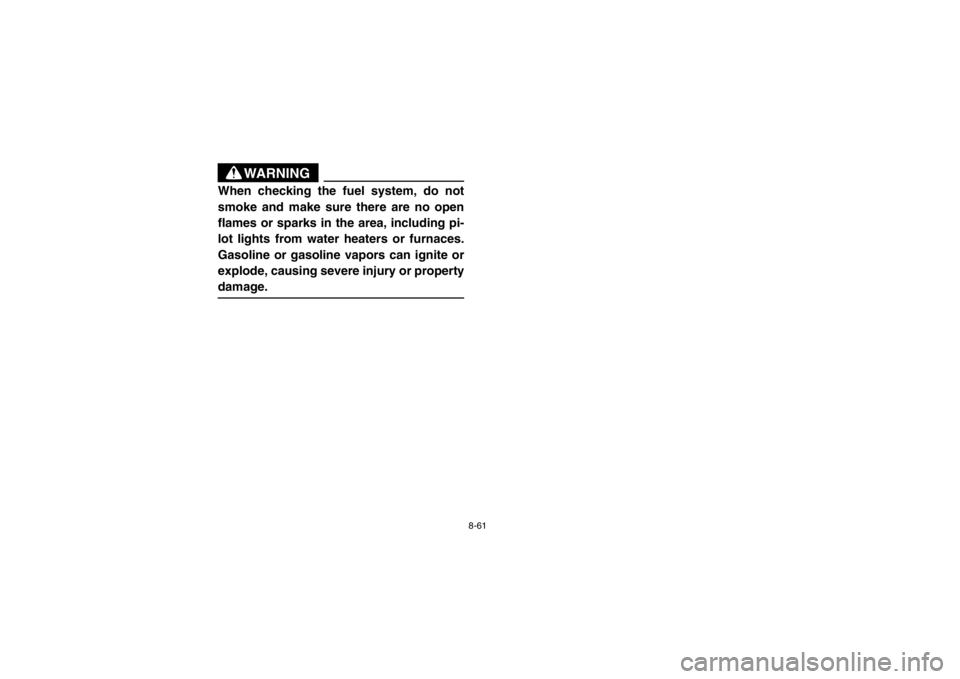
8-61
WARNING
When checking the fuel system, do not
smoke and make sure there are no open
flames or sparks in the area, including pi-
lot lights from water heaters or furnaces.
Gasoline or gasoline vapors can ignite or
explode, causing severe injury or property
damage.1RB7A_EE.book Page 61 Tuesday, April 24, 2012 9:07 AM
Page 175 of 188
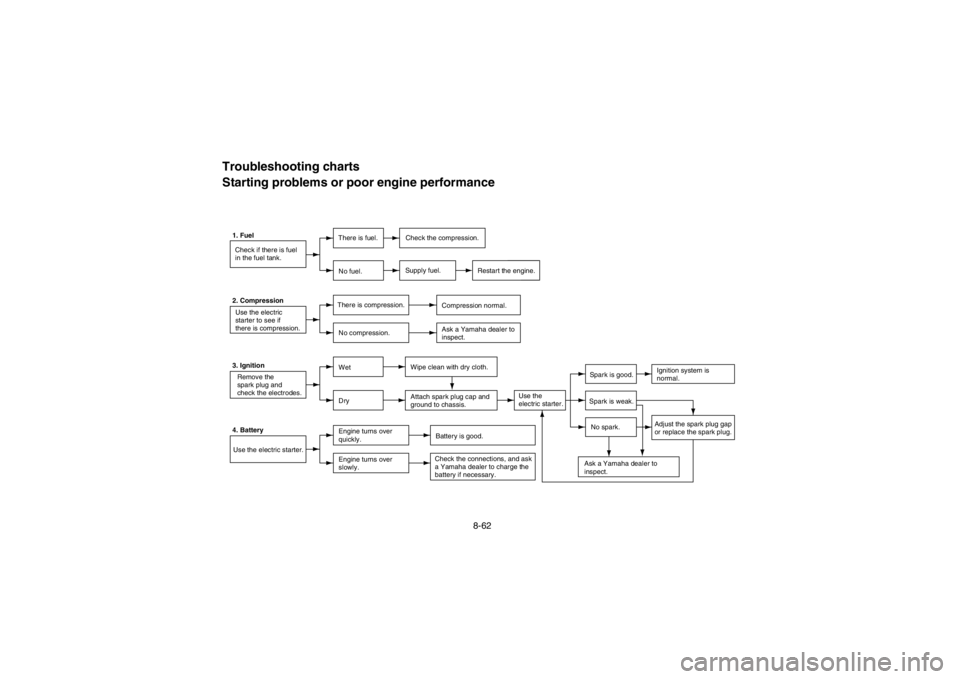
8-62
5B410024Troubleshooting charts
Starting problems or poor engine performance1. FuelCheck if there is fuel
in the fuel tank. There is fuel.
Restart the engine.
No fuel. Supply fuel.
2. Compression Use the electric
starter to see if
there is compression. There is compression.
Compression normal.
No compression. Ask a Yamaha dealer to
inspect.
3. Ignition Remove the
spark plug and
check the electrodes. Wet
Wipe clean with dry cloth.
Dry Attach spark plug cap and
ground to chassis. Use the
electric starter.Spark is good.
Ignition system is
normal.
Spark is weak.
Adjust the spark plug gap
or replace the spark plug.
No spark.
Ask a Yamaha dealer to
inspect.
4. Battery
Use the electric starter. Engine turns over
quickly.
Battery is good.
Engine turns over
slowly.
Check the compression.
Check the connections, and ask
a Yamaha dealer to charge the
battery if necessary.
1RB7A_EE.book Page 62 Tuesday, April 24, 2012 9:07 AM
Page 176 of 188
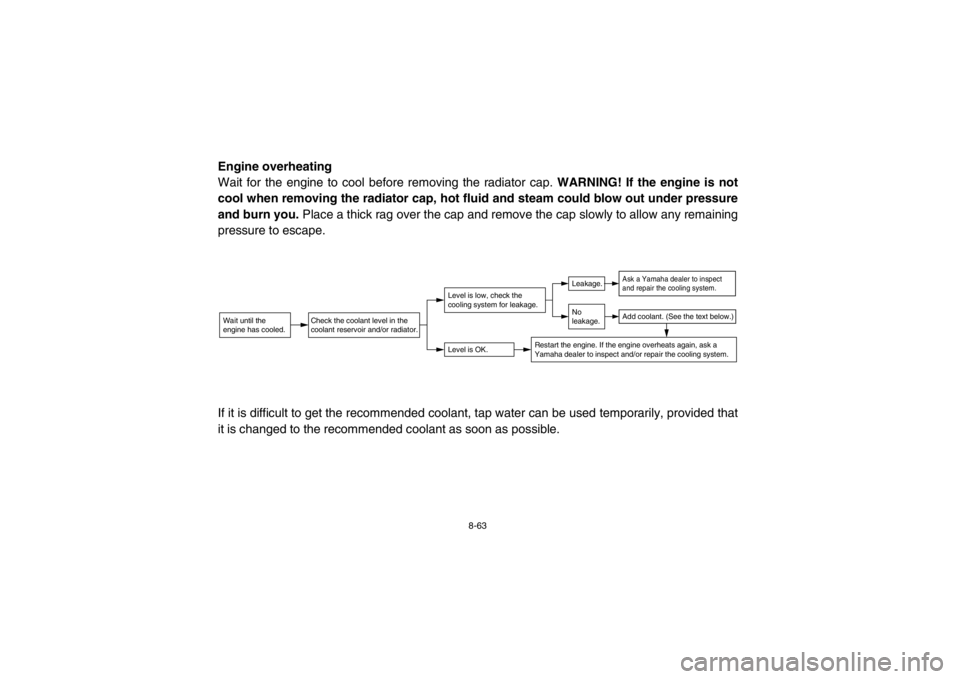
8-63
Engine overheating
Wait for the engine to cool before removing the radiator cap. WARNING! If the engine is not
cool when removing the radiator cap, hot fluid and steam could blow out under pressure
and burn you. Place a thick rag over the cap and remove the cap slowly to allow any remaining
pressure to escape.
If it is difficult to get the recommended coolant , tap water can be used temporarily, provided that
it is changed to the recommended coolant as soon as possible.Wait until the
engine has cooled.
Check the coolant level in the
coolant reservoir and/or radiator.
Level is OK.Level is low, check the
cooling system for leakage.
No
leakage.Leakage.
Ask a Yamaha dealer to inspect
and repair the cooling system.Add coolant. (See the text below.)
Restart the engine. If the engine overheats again, ask a
Yamaha dealer to inspect and/or repair the cooling system.
1RB7A_EE.book Page 63 Tuesday, April 24, 2012 9:07 AM
Page 177 of 188

9-1
1
2
3
4
5
6
7
89
10
11
12
13
14
EVU01030
1-CLEANING AND STORAGE
A. Cleaning
Frequent, thorough cleaning of your vehicle
will not only enhance its appearance but will
improve its general performance and extend
the useful life of many components.1. Before cleaning the vehicle:
a. Block off the end of the exhaust pipeto prevent water entry. A plastic bag
and strong rubber band may be used.
b. Make sure the spark plug and all filler caps are properly installed.
2. If the engine case is excessively greasy,
apply degreaser with a paint brush. Do
not apply degreaser to the wheel axles. 3. Rinse the dirt and degreaser off with a
garden hose. Use only enough pressure
to do the job. WARNING! Test the
brakes after washing. Apply the
brakes several times at slow speeds
to let friction dry out the linings. Wet
brakes may have reduced stopping
ability, increasing the chance of an ac-
cident. NOTICE: Excessive water
pressure may cause water seepage
and deterioration of wheel bearings,
brakes, transmission seals and elec-
trical devices. Many expensive repair
bills have resulted from improper
high-pressure detergent applications,
such as those available in coin-oper-
ated car washers.1RB7A_EE.book Page 1 Tuesday, April 24, 2012 9:07 AM
Page 178 of 188

9-2
4. Once the majority of the dirt has beenhosed off, wash all surfaces with warm
water and mild, detergent-type soap. An
old toothbrush or bottle brush is handy for
hard-to-get-at places.
5. Rinse the vehicle off immediately with
clean water and dry all surfaces with a
clean chamois towel or soft, absorbent
cloth.
6. Clean the seats with a vinyl upholstery cleaner to keep the covers pliable and
glossy.
7. Automotive-type wax may be applied to all painted and chrome-plated surfaces.
Avoid combination cleaner-waxes. Many
contain abrasives which may scratch the
paint or protective finish. When finished,
start the engine and let it idle for several
minutes.
5B410025B. Storage
Long term storage (60 days or more) of your
vehicle will require some preventive proce-
dures to guard against deterioration. Make
any necessary repairs before storing the vehi-
cle.
After thoroughly cleaning the vehicle, prepare
for storage as follows:1. Fill the fuel tank with fresh fuel and add
the specified amount of Yamaha Fuel
Stabilizer and Conditioner or equivalent
product. Operate the vehicle for at least
5 minutes to distribute treated fuel
through the fuel system.
Specified amount: 1 oz of stabilizer to each gallon of fuel (or
7.5 ml of stabilizer to each liter of fuel)
1RB7A_EE.book Page 2 Tuesday, April 24, 2012 9:07 AM
Page 179 of 188

9-3
2. Remove the spark plug, pour a tea-spoonful of engine oil into the spark plug
bore and install the spark plug. Ground
the spark plug wire and turn the engine
over several times to coat the cylinder
wall with oil.
3. Lubricate all control cables.
4. Block up the frame to raise all wheels off the ground.
5. Tie a plastic bag over the exhaust pipe outlet to prevent moisture from entering.
6. If storing in a humid or salt-air atmo-
sphere, coat all exposed metal surfaces
with a light film of oil. Do not apply oil to
any rubber parts or the seat covers. 7. Remove the battery and charge it. Store
it in a dry place and recharge it once a
month. Do not store the battery in an ex-
cessively warm or cold place [less than
0 °C (30 °F) or more than 30 °C (90 °F)].
Use of fuel stabilizer and conditioner elimi-
nates the need to drain the fuel system. Con-
sult a Yamaha dealer if the fuel system needs
to be drained.
1RB7A_EE.book Page 3 Tuesday, April 24, 2012 9:07 AM
Page 180 of 188

10-1
EBU25960
1-SPECIFICATIONS
Dimensions:Overall length:2885 mm (113.6 in)
Overall width: 1385 mm (54.5 in)
Overall height:
YXR7FD 1853 mm (73.0 in)
YXR7FSPD 1901 mm (74.8 in)
YXR700FAD 1853 mm (73.0 in)
Seat height: 818 mm (32.2 in)
Wheelbase:
1910 mm (75.2 in)
Ground clearance: 280 mm (11.0 in)
Minimum turning radius: 3900 mm (154 in)Weight:With oil and fuel:YXR7FD 540.0 kg (1190 lb)
YXR7FSPD 548.0 kg (1208 lb)
YXR700FAD 540.0 kg (1190 lb)Noise and vibration level:Noise level (77/311/EEC):YXR7FD 80.2 dB(A)
YXR7FSPD 80.2 dB(A)
Vibration on seat (EN1032, ISO5008): YXR7FD Will not exceed 0.5 m/s
2
YXR7FSPD Will not exceed 0.5 m/s2
Vibration on handlebar (EN1032, ISO5008): YXR7FD Will not exceed 2.5 m/s
2
YXR7FSPD Will not exceed 2.5 m/s2
Engine:Engine type: Liquid cooled 4-stroke, SOHC
Cylinder arrangement: Single cylinder
Displacement:
686 cm³
Bore × stroke:
102.0 × 84.0 mm (4.02 × 3.31 in)
Compression ratio: 9.20 : 1
Starting system:
Electric starter
Lubrication system: Wet sumpEngine oil:Recommended brand:
YAMALUBE
1RB7A_EE.book Page 1 Tuesday, April 24, 2012 9:07 AM